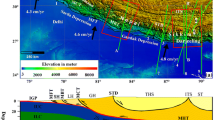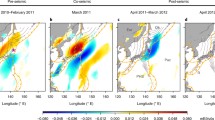Abstract
Satellite gravity data of the regional rheological structure of the lithosphere in the vicinity of Sumatra is used as evidence to enable a better understanding of the regional geodynamic environment. The data is interpreted using the theory of post-seismic viscoelastic relaxation. Co- and post-seismic changes in the gravity field resulting from the 2004 M w9.3 Sumatra earthquake were calculated from Gravity Recovery and Climate Experiment (GRACE) satellite data. A spatial Gaussian filter, 500 km wide, was used in the calculation. The results indicate that there were significant co-seismic jumps in both uplifted and subducted regions. The magnitude of the jump in the subducted zone was ∼9×10−8 m/s2, more significant than the ∼2×10−8 m/s2 jump observed in the uplifted zone. However, a positive gravity change occurred in the uplifted zone very soon after the earthquake. The rheological structure of the lithosphere has a great effect on deformation and its determination is a fundamental part of developing reliable numerical simulations in geodynamics. Based on the temporally-variable gravity field observed by GRACE, the viscous lithospheric structure of the Sumatra area is investigated with a self-gravitating, half space, viscoelastic earth model. The estimated viscosity is of the order of 1.0×1018 Pa·s and there are differences in the rheological parameters on the two sides of the fault. The factors that affect the viscosity are discussed in connection with the tectonic structure of the Sumatra area.
Similar content being viewed by others
References
Ma Z J, Ye H. The Dec. 26, 2004 Sumatra-Andaman earthquake: Tectonic setting and the tsunami disaster (in Chinese). Earth Sci Front, 2005, 12: 281–287
Ammon C J, Chen J, Thio H, et al. Rupture process of the 2004 Sumatra- Andaman earthquake. Science, 2005, 308: 1133–1139
Tsai V C, Nettles M, Ekström G, et al. Multiple CMT source analysis of the 2004 Sumatra earthquake. Geophys Res Lett, 2005, 32: L17304, doi: 10.1029/2005GL023813
Han S C, Shum C K, Bevis M, et al. Crustal dilatation observed by GRACE after the 2004 Sumatra-Andaman earthquake. Science, 2006, 313: 658–666
Hoechner A, Babeyko A Y, Sobolev S V. Enhanced GPS inversion technique applied to the 2004 Sumatra earthquake and tsunami. Geophys Res Lett, 2008, 35: L08310, doi: 10.1029/2007GL033133
Ogawa R, Heki K. GRACE detects coseismic and postseismic deformation from the Sumatra-Andaman earthquake. Geophys Res Lett, 2007, 34: L06313, doi: 10.1029/2007GL029340
Chen J L, Wilson C R, Tapley B D, et al. GRACE detects coseismic and postseismic deformation from the Sumatra-Andaman earthquake. Geophys Res Lett, 2007, 34: L13302, doi: 10.1029/2007GL030356
Panet I, Mikhailov V, Diament M, et al. Coseismic and post-seismic signatures of the Sumatra 2004 December and 2005 March earthquakes in GRACE satellite gravity. Geophys J Int, 2007, 171: 177–190
Sun W, Okubo S. Co-seismic deformations detectable by satellite gravitymissions—A case study of Alaska (1964, 2002) and Hokkaido (2003) earthquakes in the spectral domain. J Geophys Res, 2004, 109: B04405, doi: 10.1029/2003JB002554
Pollitz F F, Bürgmann R, Banerjee P. Postseismic relaxation following the great 2004 Sumatra-Andaman earthquake on a compressible self-gravitating Earth. Geophys J Int, 2006, 167: 397–420
Pollitz F F, Banerjee P, Grijalva K, et al. Effect of 3-D viscoelastic structure on post-seismic relaxation from the 2004 M=9.2 Sumatra earthquake. Geophys J Int, 2008, 173: 189–204
de Linage C, Rivera L, Hinderer J, et al. Separation of coseismic and postseismic gravity changes for the 2004 Sumatra-Andaman earthquake from 4.6 yr of GRACE observations and modelling of the coseismic change by normal-modes summation. Geophys J Int, 2009, 176: 695–714
Scholz C H, Molnar P, Johnson T. Detailed studies of the frictional sliding of granite and implications for the earthquake mechanisms. J Geophys Res, 1972, 77: 6392–6406
Sheu S Y, Shieh C F. Viscoelastic-afterslip concurrence: A possible mechanism in the early post-seismic deformation of the M w7.6, Chi-Chi (Taiwan) earthquake. Geophys J Int, 2004, 159: 1112–1124
Deng J, Gurnis M, Kanamori H, et al. Viscoelastic low in the lower crust after the 1992 Landers, California, earthquake. Science, 1998, 282: 1689–1692
Árnadóttir T, Jónsson S, Pollitz F F, et al. Postseismic deformation following the June 2000 earthquake sequence in the south Iceland seismic zone. J Geophys Res, 2005, 110: B12308, doi: 10.1029/2005JB003701
Melosh H, Raefsky A. The dynamic origin of subduction zone topography. Geophys J R astr Soc, 1980, 60: 8441–8451
Lorenzo M F, Roth F, Wang R. Inversion for rheological parameters from post-seismic surface deformation associated with the 1960 Valdivia earthquake, Chile. Geophys J Int, 2006, 164: 75–87
Jonsson S, Segall P, Pedersen R, et al. Post-earthquake ground movements correlated to pore-pressure transients. Nature, 2003, 424: 179–183
Masterlark T, Wang H F. Transient stress-coupling between the 1992 Landers and 1999 Hector Mine, California, Earthquakes. Bull Seism Soc Am, 2003, 92: 1470–1486
Wahr J, Molenaar M, Bryan F. Time-variability of the Earth’s gravity field: Hydrological and oceanic effects and their possible detection using GRACE. J Geophys Res, 1998, 103: 30205–30230
Wahr J, Swenson S, Zlotnicki V, et al. Time-variable gravity from GRACE: first results. Geophys Res Lett, 2004, 31: L11501, doi: 10.1029/2004GL019779
Chen J L, Wilson C R, Famiglietti J S, et al. Spatial sensitivity of the Gravity Recovery and Climate Experiment (GRACE) time-variable gravity observations. J Geophys Res, 2005, 110: B08408, doi: 10.1029/2004JB003536
Fantino E, Casotto S. Methods of harmonic synthesis for global geopotential models and their first-, second-, and third-order gradients. J Geod, 2009, 83: 595–619
Franz B. Definition of functionals of the geopotential and their calculation from spherical harmonic models. Technical Report, Deutsches GeoForschungs Zentrum GFZ. 2009
Lyard F, Lefevre F, Letellier T, et al. Modelling the global ocean tides: Insights from FES2004. Ocean Dyn, 2006, 56: 394–415
McCarthy D D, Petit. G. IERS Conventions (2003). IERS Technical Note No. 32, Bundesamts für Kartogr und Geod, Frankfurt, Germany. 2003
Desai S D. Observing the pole tide with satellite altimetry, J Geophys Res, 2002, 107: 3186, doi: 10.1029/2001JC001224
Bettadpur S. Gravity Recovery and Climate Experiment Level-2 Gravity Field Product User Handbook, Center for Space Research, Austin, Texas, 2007. Rep. GRACE 327-734
Bettadpur S. CSR Level-2 processing standards document for product release 04, Center for Space Research, Austin, Texas, 2007. Rep. GRACE 327-742
Jekeli C. Alternative methods to smooth the Earth’s gravity field. Technical Report, Department of Geodetic Science and Surveying, Ohio State University. 1981
Han S C, Shum C K, Jekeli C, et al. Non-isotropic filtering of GRACE temporal gravity for geophysical signal enhancement. Geophys J Int, 2005, 163: 18–25
Chen J L, Wilson C R, Seo K W. Optimized smoothing of Gravity Recovery and Climate Experiment (GRACE) time-variable gravity observations. J Geophys Res, 2006, 111: B06408, doi: 10.1029/ 2005JB004064
Swenson S, Wahr J. Post-processing removal of correlated errors in GRACE data. Geophys Res Lett, 2006, 33: L08402, doi: 10.1029/2005GL025285
Sasgen I, Martinec Z, Fleming K. Wiener optimal filtering of GRACE data. Stud Geophys Geod, 2006, 50: 499–508
Zhang Z Z, Chao B F, Lu Y, et al. An effective filtering for GRACE time-variable gravity: Fan filter. Geophys Res Lett, 2009, 36: L17311, doi: 10.1029/2009GL039459
Chen J L, Wilson C R, Famiglietti J S, et al. Spatial sensitivity of the Gravity Recovery and Climate Experiment (GRACE) time-variable gravity observations. J Geophys Res, 2005, 110: B08408, doi: 10.1029/2004JB003536
Wang R, Lorenzo-Martin F, Roth F. PSGRN/PSCMP-A new code for calculating co- and post-seismic deformation, geoid and gravity changes based on the viscoelastic-gravitational dislocation theory. Comput Geosci, 2006, 32: 527–541
Kennett B L N, Engdahl E R. Traveltimes for global earthquake location and phase identification. Geophys J Int, 1991, 105: 429–465
Sun W, Okubo S, Fu G, et al. General formulations of global co-seismic deformations caused by an arbitrary dislocation in a spherically symmetric earth model-Applicable to deformed earth surface and space-fixed point. Geophys J Int, 2009, 177: 817–833
Banerjee P, Pollitz F, Nagarajan B, et al. Coseismic slip distributions of the 26 December 2004 Sumatra-Andaman and 28 March 2005 Nias earthquakes from GPS static offsets. Bull Seism Soc Am, 2007, 97: S86–S102
Hirth G, Kohlstedt D L. Rheology of the upper mantle and the mantle wedge: A view from the experimentalists. In: Eiler J, ed. Inside the Subduction Factory. AGU Monograph, 2003, 138: 83–105
Shi Y L, Cao J L. Effective viscosity of China continental lithosphere (in Chinese). Earth Sci Front, 2008, 15: 082–095
Zhang C J, Cao J L, Shi Y L. Studying the viscosity of lower crust of Qinghai-Tibet Plateau according to post-seismic deformation. Sci China Ser D-Earth Sci, 2009, 52: 411–419
Tanaka Y, Klemann V, Fleming K, et al. Spectral finite element approach to postseismic deformation in a viscoelastic self-gravitating spherical Earth. Geophys J Int, 2009, 176: 715–739
Cannelli V, Melini D, Piersanti A, et al. Post-seismic signature of the 2004 Sumatra earthquake on low-degree gravity harmonics. J Geophys Res, 2008, 113: B12414, doi: 10.1029/2007JB005296
Čadek O, Fleitout L. Effect of lateral viscosity variations in the top 300 km on the geoid and dynamic topography. Geophys J Int, 2003, 152: 566–580
Gaherty J, Jordan T, Gee L. Seismic structure of the upper mantle in a central Pacific corridor. J Geophys Res, 1996, 101: 22291–22309
Fu R S, Chang X H, Huang J H, et al. Regional gravity isostatic anomaly and small scale convection model in upper mantle (in Chinese). Chin J Geophys, 1994, 37(Suppl): 249–258
Ryder I, Parsons B, Wright T J, et al. Post-seismic motion following the 1997 Manyi (Tibet) earthquake: InSAR observations and modeling. Geophys J Int, 2007, 169: 1009–1027
Shen Z K, Zeng Y, Wang M, et al. Postseismic deformation modeling of the 2001 Kokoxili earthquake, western China. Geophys Res Abs, 2003, 5: 07840
Author information
Authors and Affiliations
Corresponding author
Rights and permissions
About this article
Cite this article
Wang, W., Shi, Y., Sun, W. et al. Viscous lithospheric structure beneath Sumatra inferred from post-seismic gravity changes detected by GRACE. Sci. China Earth Sci. 54, 1257–1267 (2011). https://doi.org/10.1007/s11430-011-4217-y
Received:
Accepted:
Published:
Issue Date:
DOI: https://doi.org/10.1007/s11430-011-4217-y




